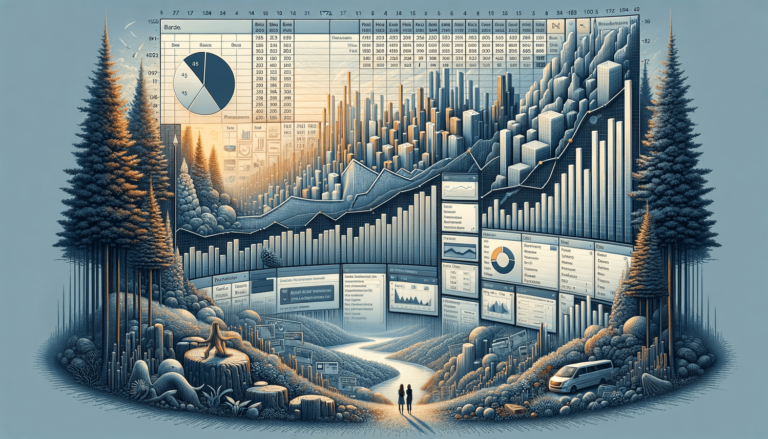

Do you need to create a bar graph in Excel? Look no further, as we’ve got you covered. Bar graphs are a visual representation of data used to compare values across categories. Excel provides an easy and efficient way to create them. In this blog post, we’ll provide a step-by-step guide on how to create a bar graph in Excel. Regardless of your level of experience with Excel, you’ll be able to follow along and create a professional-looking bar graph in no time.
The first step in creating a bar graph in Excel is to gather your data. Ensure that the data is clean and organized. If you have multiple sets of data, combine them into a single table. We recommend including column labels so that it is clear what each row in your data represents.
Next, select the data that you want to include in your graph. Click and drag your cursor over the cells that contain the data you want to use. If you have column and row labels, make sure to include those as well.
With your data selected, click on the “Insert” tab in the menu bar. Find the “Charts” section and select “Bar.” From there, choose the particular style of bar graph you want to create.
Once your graph has been created, you can customize it to your liking. Click on the graph and look for the “Chart Design” and “Format” tabs in the menu bar. From these tabs, you can add chart elements and change the style and color of your bars.
If your data changes, you can easily update your bar graph in Excel. Simply click on the graph to select it and then right-click and choose “Select Data.” From there, you can update your data by adding or removing rows or columns.
Creating a bar graph in Excel is a simple process that anyone can master. By gathering your data, selecting it, inserting your graph, customizing its appearance, and updating it as needed, you can quickly and easily create a professional-looking visualization of your data.
Excel offers several types of bar graphs that you can choose from when creating a new graph. Some of the most common types include horizontal, stacked, and grouped bar graphs. It’s important to choose the type of graph that best represents your data and makes it easy to interpret. For example, a horizontal bar graph may be better suited for data that has long category labels and short data values.
Data labels can help to clarify the information presented on your bar graph. You can add data labels to each individual bar, or to the overall data set. To add data labels, select your graph and then click on the “Chart Elements” icon in the top right corner. From there, check the box next to data labels and choose the positioning and format that works best for your data.
Once you have created and customized your Excel bar graph, you may want to save it and share it with others. To save your graph, simply click the “Save” icon in the top left corner of the screen or use the “Save As” option to choose a specific file name or file location. To share your graph, you can either copy and paste it into a document or presentation, or save it as an image file to share online or via email.
While Excel is a great tool for creating bar graphs, there are also several alternatives available if you want to explore other options. These alternatives include online graphing tools like Canva and Google Sheets, or dedicated graphing software like Tableau and Stata. Depending on your needs and level of expertise, you may find that one of these alternatives better suits your needs and preferences.
Here are some common questions and answers related to creating bar graphs in Excel:
Bar graphs in Excel are best suited for comparing values across categories. For example, if you wanted to compare the sales of different products within a specific time frame. Vertical bar graphs are great for visualizing data where the bars are relatively narrow, with long data labels. Conversely, horizontal bar graphs are better if the bars are wider, and short data labels are used.
Yes! Excel provides users with a lot of customization options. To change the color and style of your bar graph, you can click on the graph and then select the “Chart Design” and “Format” tabs in the menu bar. From there, you can choose from a range of colors, styles and effects to customize your graph.
Yes! You can easily add more data to your bar graph by right-clicking the graph and selecting “Select Data”. From there, you can select the range that contains your new data, or add it manually to the table. You can even add an entirely new set of data to your graph.
Yes! If you need to remove specific data from your bar graph, select the graph and then choose “Select Data”. From there, select the data series you want to remove and click “Remove”.
If you need to share your Excel bar graph with someone who doesn’t have Excel, you can save your graph as an image file (such as a jpeg or png) and then send it as an attachment or embed it in a document or presentation. To save your graph as an image file, right-click on the graph and choose “Save as Picture”.
Explore the world of Microsoft PowerPoint with LearnPowerpoint.io, where we provide tailored tutorials and valuable tips to transform your presentation skills and clarify PowerPoint for enthusiasts and professionals alike.

Your ultimate guide to mastering Microsoft Word! Dive into our extensive collection of tutorials and tips designed to make Word simple and effective for users of all skill levels.

Boost your brand's online presence with Resultris Content Marketing Subscriptions. Enjoy high-quality, on-demand content marketing services to grow your business.
